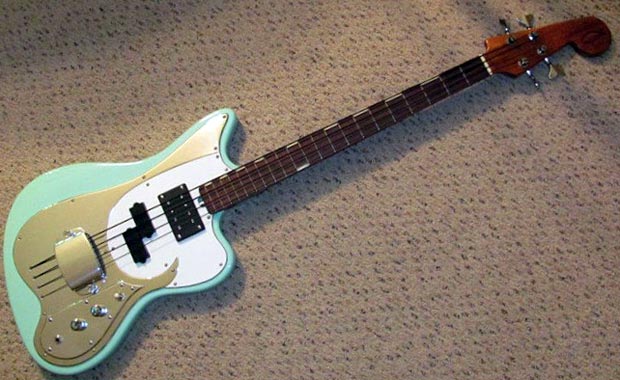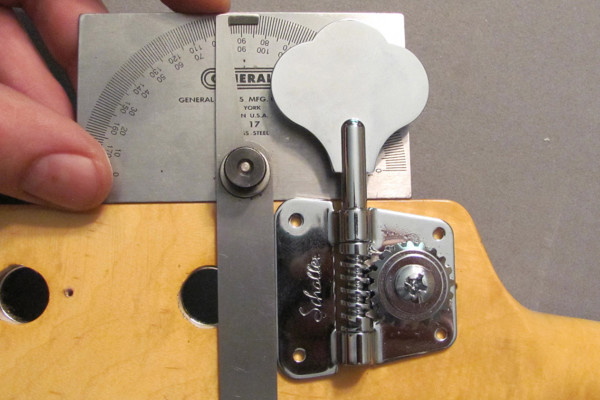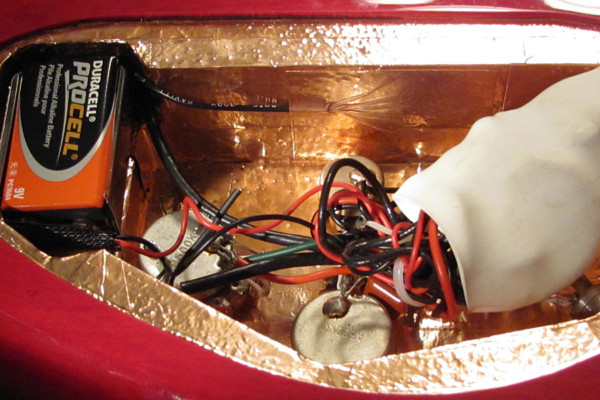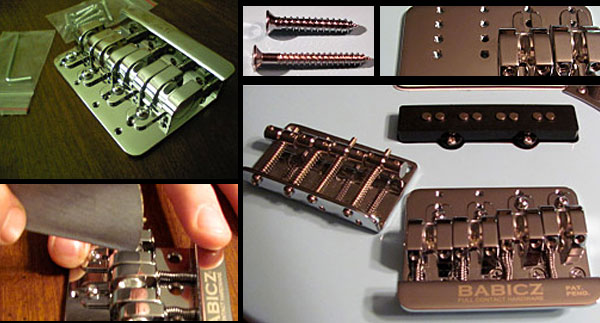To Mod or Not to Mod: Considerations for Modifying Your Bass
You guys have followed me through a few projects now and, if I?ve done my job, some of you have been inspired to take an instrument and make it fit you better in some way.
This month, I want to talk about why we do this and pose some questions you should answer for yourself if you?re considering upgrading or modding your bass.
There are as many different reasons one might modify an instrument, but it all pretty much boils down to this: most basses are made for the masses, and we are individuals. We all have different taste, we approach the instrument in different ways, and we have our own opinion about what sounds good and what doesn?t. There?s nothing wrong with that! There?s no reason you shouldn’t make your bass do exactly what you need or want it to do. When your bass serves you better, you will be able to better serve the music.
If you have a mod in mind for your bass (or several), then you have already identified a need or some room for improvement. Allow me to suggest that you might make a sort of list here that will help you decide what the real benefit is to you, and if you have more than one project in mind, how to prioritize them. I lump a lot of different upgrades into a few basic categories and prioritize them in this way. Of course, you may prioritize them in a different order, and it really comes down to what?s important to you.
- Function and feel
- Performance and tone
- Aesthetics
Let?s break these down a little.
Function and Feel
For me, it starts with the neck. If you have a neck that?s stable and feels good in your hand, you have a keeper. Absent that, there isn?t much limit to what you can do right at home, with hand tools, to improve the way your bass works.
If there are things about the switching system or volume and tone controls you don?t like, it?s usually not that hard to change things around. Maybe you have two pickups with individual volume controls, and a selector switch makes more sense to you. Or maybe one volume with a blend pot. Whatever seems more intuitive to you is what you should have, and it will allow you to be able to control your bass without giving it a distracting thought. Personally, I like passive basses, and I use the tone control a lot while the volume control basically gets used as an on/off switch. As such, I always move the tone knob closest to my hand.
Performance and Tone
If you have a bass that feels good and works the way you want it to, you?re off to a great start. How does your bass perform? Does it tune up easily and stay in tune? Does it have enough sustain for you? Does it intonate well?
How about the sound? Is it too bright? Not bright enough? Is the bottom end tight and defined or is it muddy?
These things can all be changed. It can start as simply as experimenting with different strings and finding the right set for your bass, or it can involve new hardware or electronics.
Keep in mind that it?s tough to electronically reproduce a tonal characteristic that your bass doesn?t already have. Here?s an example: If you have a bass that?s a little muddy or weak in the bottom end, it may be a result of the hardware the strings are anchored to, or even the body material. If this is the case, you won?t hear much improvement by dropping a better pickup in. That’s why I usually start with hardware upgrades (if needed) before I replace pickups or other electronics.
Aesthetics
Ok, you?ve got a bass that feels good, functions the way you like and sounds good to you. Now you?re really ahead of the game. A lot of people would be perfectly content with that and, really, they should be. All the important stuff is covered. There?s only one reason to change the way your bass looks, and that’s because you want to. This is more important to some people than it is to others, as there?s just something about adding a touch of our own style to our basses that appeals to many of us. It can be something as simple as changing the knobs out or as involved as changing the shape of the body. The aftermarket is full of visual upgrades for most popular basses and, if you?re inclined to tackle more than replacing parts, the creative possibilities are endless.
Here?s an extreme example:

This was a Teisco Del Rey at one time. It has all new electronics and hardware, the body?s been reshaped and it has custom made aluminum work and pick guard on the body. This is a fun little bass to play (it is a 30″ inch scale) and it?s been a fun, ongoing project.
Now, you?ve determined whether there?s room for improvement somewhere and come up with some idea?s to make your bass fit you better. It?s time to decide if you?re really going to go through with it. There are three questions you need to ask for yourself before you tackle any project:
- Do I have the tools and equipment needed to do the job?
- Am I confident I can pull it off?
- Is it worth it?
A lot of the mods we touched on here can be done with hand tools most people already have. Many of them require more than that. If you don?t have the power tools required to tackle a project you?d like to take on, then maybe you know someone who does. If not, you?ll have to add the cost of renting or purchasing the required tools for the project.
If you don?t have the experience or the knowledge to go into a particular project with confidence, get it. There is information available on any project you can dream up, right on your computer. There are forums and instructional sites where you can learn just about anything you need to know. Take some time to do the research, and definitely ask questions on the forums. Any steps you can take to make yourself more proficient will pay off in the long run.
When deciding whether to put time or money into an instrument, you have to determine if it?s worth it to you. Keep in mind that putting a bunch of costly upgrades on your bass is not necessarily going to make it worth more money to someone else. Having said that, if it?s a bass you like and you?re going to keep it and play it, who cares what it?s worth to someone else? If your bass isn?t for sale, it?s worth whatever you say it?s worth.
Also keep in mind that you should calculate the risk if you?re contemplating doing anything invasive. You should ask yourself what could go wrong and whether the cost of fixing a mistake would be too much. I?ve lost count of the times I?ve taken a router to a bass body, and I?ve never done damage to one. I still ask myself every time I do it, “If this goes bad, can I replace this body?”
Always do your homework. Make the proper preparations and set yourself up for success, but don?t forget the contingency plan. If I wreck this thing, am I still going to be able to make the gig tomorrow?
An instrument is an extension of the musician. A bass is nothing more than a tool, but we do get attached to our tools! We figure out the little quirks they have and learn to work with them. We learn how they will react to different environments and how they will sound through different systems. Over time, we don?t have to think too much about the bass and can concentrate more on the music. This experience makes us more proficient. Modding your bass is just taking that to the next level and making it fit you the best that it can. Anything you can do to make your bass fit you and the way you play is going to allow it to be a better extension of you as a player. Go for it. Make it yours!
Join me next month and we?ll take a look at my latest purchase. We?ll give it a good once over, look for problems that may need attention and give it a proper set up. We?ll determine whether a gamble paid off with a bargain and try to unravel the mystery behind this fiasco. We may never know!





Well writen article Rob.
Excellent article. Thanks!
my leo quan badass 2 bridge was the last thing that I modded on my jazz bass and after installing it(took it to a professional and paid almost 200 dollars to have it done right) I found out that this mod should have been the very FIRST one I did it made playing my bass efortless made me twice a better bass player because the action was so low and easy to play and the sustain and added low range from this chunky bridge was amazing.
but it was the most expensive mod sot hats why i did it last. this mod actually cost me more then i paid for the bass (bought it used) the bridge was over 100 dollars ment i had to buy a brand new set of strings (50 dollars) and had to pay 200 dollars to get it installed. i almost paid a shade tree music guy that was something of a local legend but at the alst minute i thought better and took it to an official luthier and he did such an amazing job i do not regret my decision at all money well spent!
Phillip Wager: $200 to install a bridge is highway robbery. $50-75 over the cost of the bridge is fair including a setup. Glad you are happy with the results.
Bobby Devlin that was including new elixer strings and tax is very high where i live i got the bridge as a gift and they said if i bought the bridge from them they would have installed it for cheaper. this was also the best place in town for guitar repair/modding so they were more expensive then any other place but they did it right so im very happy
Good article, Rob. I’ve been thinking about going from active back to passive myself. Something to think about.
I wish I had seen this article about 2 months ago. I just finished a complete rebuild of my old mid-80’s Squier P bass into something that I can use. The only original part remaining is the body. Stripped off the paint, new bridge, tuners, p-ups, neck, controls.. the works. I had never attempted any major changes before so this was a challenge. I even did all of the soldering, filed down and crowned the frets and attempted my own relic-ing work. I have to say I’m pretty impressed with how it turned out and will be a decent 3rd bass. Looks preety good and sounds waaayy better. I would recommend doing all of your own work and ‘hotel room’ repairs. There are a lot of good videos on You Tube for help and instruction and it made me more confident in any issues that may arise at a show, too! Now go do it!
just finished workin on an ibanez BTB406 that i picked up in rough second hand shape. done basic repairs then stripped body and reshaped neck and a good setup now it feels n plays so well for me. plus i think everyone should do this once just to get a proper feel for how our basses work
I really miss my old Teisco bass…loved that model.